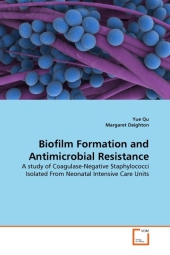 Neuerscheinungen 2010Stand: 2020-01-07 |
Schnellsuche
ISBN/Stichwort/Autor
|
Herderstraße 10
10625 Berlin
Tel.: 030 315 714 16
Fax 030 315 714 14
info@buchspektrum.de |

Margaret Deighton, Yue Qu
(Beteiligte)
Biofilm Formation and Antimicrobial Resistance
A study of Coagulase-Negative Staphylococci Isolated From Neonatal Intensive Care Units
2010. 220 S.
Verlag/Jahr: VDM VERLAG DR. MÜLLER 2010
ISBN: 3-639-29939-6 (3639299396)
Neue ISBN: 978-3-639-29939-7 (9783639299397)
Preis und Lieferzeit: Bitte klicken
This study investigated antimicrobial susceptibilities of clinical CoNS isolates in different stages of the biofilm formation process. Planktonic cells exhibited similar susceptibilities in comparison with early adherent monolayers. A mature biofilm showed similar resistance to antimicrobial eradication to planktonic cells at stationary phase. In order to investigate mechanisms of high resistance of biofilms to various antimicrobial agents, the percentages of tolerant- but-killable cells and non-killable persister cells in different bacterial populations were examined. More tolerant-but-killable cells were found in biofilms than in planktonic cultures at log phase. Persister cells were only present in biofilms, not planktonic cultures. Further study showed that ability of CoNS to adhere to polymer surfaces and grow into a highly dense mode, rather than their ability to build up biofilm matrix, contributed to their high resistance to antimicrobial agents. Finally, different agents were tested as catheter lock solutions. Ethanol was found to be superior to most antimicrobial agents in eradication of biofilm cells.


